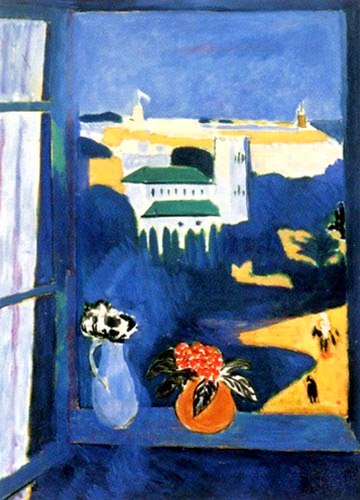 Gibbs Family Tree
Gibbs Family Tree
Obituaries and Press Articles following Christopher Henry Gibbs death on 28th July 2018
 The Times
July 31 2018 - Christopher Gibbs obituary
The Times
July 31 2018 - Christopher Gibbs obituary
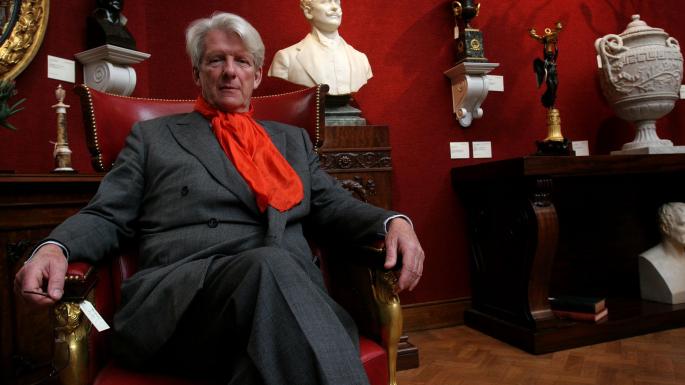
Gibbs in 2006 with some of his antiques in one of
the sales rooms of Christies in London
One night in the summer of 1968 Christopher Gibbs was partying
hard with Mick Jagger and Keith Richards at a South Kensington
nightclub. At about 2am Gibbs suggested that they adjourn to
Stonehenge to watch the sun rise.
Piling into Richards’s chauffeur- driven Bentley with the two
Stones, Marianne Faithfull and the American singer Gram Parsons,
the party arrived just in time to watch the sun come up over the
prehistoric monument, “all gibbering with acid”, as Gibbs put it.
Still high on LSD, they went to a pub in Salisbury and breakfasted
on kippers.
It was a typical day in the life of the extraordinary antiques
dealer and socialite, whose appetite for drugs earned the
admiration of Richards, who conceded that even he could not keep
up. “He was crazy,” Richards recalled in his memoir Life.
“He’s the only guy I know who would wake up and break an amyl
nitrate popper under his nose . . . He was an adventurous lad. He
was ready to jump into the unknown.”
Richards particularly enjoyed staying at Gibbs’s apartment at
Cheyne Walk on the Embankment, not only because of the endless
supply of illicit substances, but also because he could indulge in
the remarkable library. “I could just sit around, look at
beautiful first editions and great illustrations and paintings and
stuff that I hadn’t had time to get into,” Richards recalled.
Yet Gibbs was more than a mere drug buddy to the Stones. He
helped Jagger to secure the high-society introductions that he
craved; showed him around the “palaces and estates” of rural
England when he was looking to buy a place; and introduced him to
Prince Rupert Loewenstein, who became the group’s financial
manager.
Beyond the Stones and their associates Gibbs had a far wider
circle, acting as style guru and playmate to many who occupied
fashionable society in the 1960s, whether or not they could
remember being there. His antiques shop off Sloane Avenue in
Chelsea furnished with great treasures the mansions of a
generation that also included John Paul Getty Jr and Lord
Rothschild.
He was once described as “part Montesquieu, part Beau Brummell and
part Baudelaire”, while the writer James Delingpole noted that
“with his silvery hair, well-cut but rumpled suit, and diffident,
vaguely ecclesiastical air, he more closely resembles an Anglican
dean than an acid-tripping ex-roué once known as the king of
Chelsea”.
In short, Gibbs was a purveyor of exceptional and intriguing
pieces who believed that taste itself was not something that could
be learnt. “It’s something you catch,” he said, “like measles or
religion.” His position as a style guru was assured when he became
an editor of Men in Vogue, which was published between
1965 and 1970, coinciding with the “peacock revolution” in English
men’s fashion. Being a dandy is what he excelled at. “You had to
be monumentally narcissistic and have time on your hands, and just
about enough money to do it,” he declared.
Christopher Henry Gibbs was born in 1938; he had a twin sister and
four older brothers. The family had made its fortune in the guano
industry (or, as the rhyme put it: “Mr Gibbs/ Made his dibs/
Selling the turds/ Of foreign birds”). His father was Sir Geoffrey
Cokayne Gibbs, a senior civil servant during the war who in
peacetime became chairman of Antony Gibbs & Sons, the family’s
merchant bank; his uncle, Sir Humphrey Gibbs, was governor of
Rhodesia during the Unilateral Declaration of Independence.
In 1947 Sir Geoffrey inherited the rambling Manor House and estate
at Clifton Hampden, Oxfordshire, which had been in the family
since the 1840s. Young Christopher recalled a childhood spent
boating on the Thames, swimming and shooting, while also
describing the thrill of pressing his young face up against
antique-shop windows. He visited Christie’s auctions when still in
grey flannel shorts; by 14 he was sporting velvet slippers and a
monocle on a blue ribbon.
At 15 he was expelled from Eton for “various offences . . .
illicit drinking, panty raids of other boys’ rooms — that sort of
thing”. His crimes included organising a group of boys to pilfer
books from Ma Brown’s antiquarian bookshop and sell them back to
her.
He was obliged to finish his schooling at Stanbridge Earls in
Hampshire, which he described as “a school for sensitive,
difficult boys”. It was followed by his first job, as an estate
agent for Knight Frank & Rutley. This was interrupted by
National Service with the army, but he lasted only three months
before being “booted out” as medically unfit (as a child he had
polio).
There were brief studies at the Sorbonne in Paris, while back in
London he lived opposite St Paul’s Cathedral, engaging in a
dubious flirtation with the property business. At 20, and with
£10,000 from his mother, he set up as an antiques dealer,
returning from buying trips to Morocco with “rugs, lamps,
djellabas, wall hangings and the name of the best hash dealer in
Tangier”.

Gibbs with Mick Jagger and Marianne Faithfull
in Dublin, 1967
His first shop, opened in 1958, was a small place in Camden
Passage, a narrow, flagstoned alley in Islington. By 1962 he had
moved to larger premises in Elystan Street, Chelsea, where his
stock was distinguished by an eclectic richness. By now the
charming and sociable Gibbs was at the heart of the fashionable
Chelsea set. He was, by one estimation, “the most avant-garde
dresser this country has ever had”, favouring a flared trouser as
early as 1961 and with a wardrobe that mixed clothes brought back
from north Africa with the colourful reinvention of traditional
British tailoring found at places such as Blades in Dover Street.
His flat in Cheyne Walk hosted many of the gatherings of that
well-heeled bohemia, as well as providing the set for a
marijuana-smoking party scene in Michelangelo Antonioni’s film
Blow-Up (1966). Through shared acquaintances and Mrs Beaton’s Tent
in Frith Street, a common Soho haunt, his circle came to include
the Stones, whom he described as “merry company, funny, irreverent
and open-minded”.
He acted as a travel guide around Britain and Ireland for Jagger,
who in turn taught him to drive and asked him to be godfather to
one of his children. Gibbs took the singer and Marianne Faithfull
to stay with Desmond and Mariga Guinness at Leixlip Castle in Co
Kildare and in 1968 it was Gibbs who was responsible for naming
one of the era’s classic albums: the Rolling Stones’s Beggars
Banquet.
That same year he acted as designer on Nic Roeg’s notorious film
Performance, creating decadent sets for the rooms of the
fading rock-star Turner, played by Jagger with Pallenberg in
attendance. “There was so much hashish being smoked and so much
acid being dropped it’s hard to remember the decade, let alone the
film,” Gibbs remarked. His romantic associations included a brief
involvement with Rudolf Nureyev, whom he described as “quite
vigorous and stagy”.
In 1971 Gibbs moved to 118 New Bond Street, where he remained for
almost 20 years, before moving to Vigo Street and then, in 1998,
to Dove Walk, Pimlico. In all these buildings Gibbs displayed the
wonderful objects, often with extraordinary price tags, found in
the upper reaches of the London antiques trade. The Englishness of
the stock was enriched by different traditions and important
objects, often bearing an impressive provenance, and mixed with
items chosen because they were beautiful, rare or curious.
He relished the histories of Britain’s landed families, his
intuitive eye for objects of interest supported by a deep
knowledge of sales and catalogues that allowed him to make
discoveries hidden to others. The architectural historian John
Harris once suggested that were Gibbs to find himself on a desert
island, the book he would most like to have accompany him would be
his uncle’s annotated copy of the Complete Peerage. “I
like things with a past — and people, too,” Gibbs said.
His homes also revealed his gift for decoration: his houses in
Morocco; his apartments in Cheyne Walk and Albany; his country
house, Davington Priory, and, after 1980, the family’s Manor
House, which, despite being the youngest son, he inherited because
none of his siblings wished to move back.
His style proved widely influential, especially in America, and
affected the appearance of the glossy interior-design magazines,
such as World of Interiors, launched in the 1980s. His
knowledge and judgment were highly prized and he was a trustee of
the charitable trust established by his friend John Paul Getty Jr,
served on the arts panel of the National Trust, and advised the
Victoria & Albert Museum on the refurbishment of its British
galleries.
In 2000, after the death of his 90-year-old housekeeper, Gibbs
decided that he no longer needed the rambling spaces of the Manor
House. Among the objects in a two-day sale held in a vast tent on
the lawn were a Victorian stuffed two-headed lamb. Before leaving
for good he erected on a plinth a worn-out pinnacle from the
chapel at Eton College, which he had acquired through “one of the
beaks”. The Latin inscription explained that both he and the
pinnacle had been expelled.
His final destination was Tangier, where he established an elegant
home and garden on one of the mountain slopes overlooking the
Strait of Gibraltar. One visitor described him there as “wearing
wonderful kaftans”, adding: “And he looked like Moses walking in
the olive garden — very peaceful.” There were, however, some
things that he missed about England, he said, adding: “I get
homesick for snowdrops.”
Christopher Gibbs, antiques dealer, was born on July 29, 1938.
He died on July 28, 2018, aged 79
 The
Telegraph 30 July 2018 - Christopher Gibbs, dandy, antiques
dealer, aesthete and friend of Mick Jagger – obituary
The
Telegraph 30 July 2018 - Christopher Gibbs, dandy, antiques
dealer, aesthete and friend of Mick Jagger – obituary
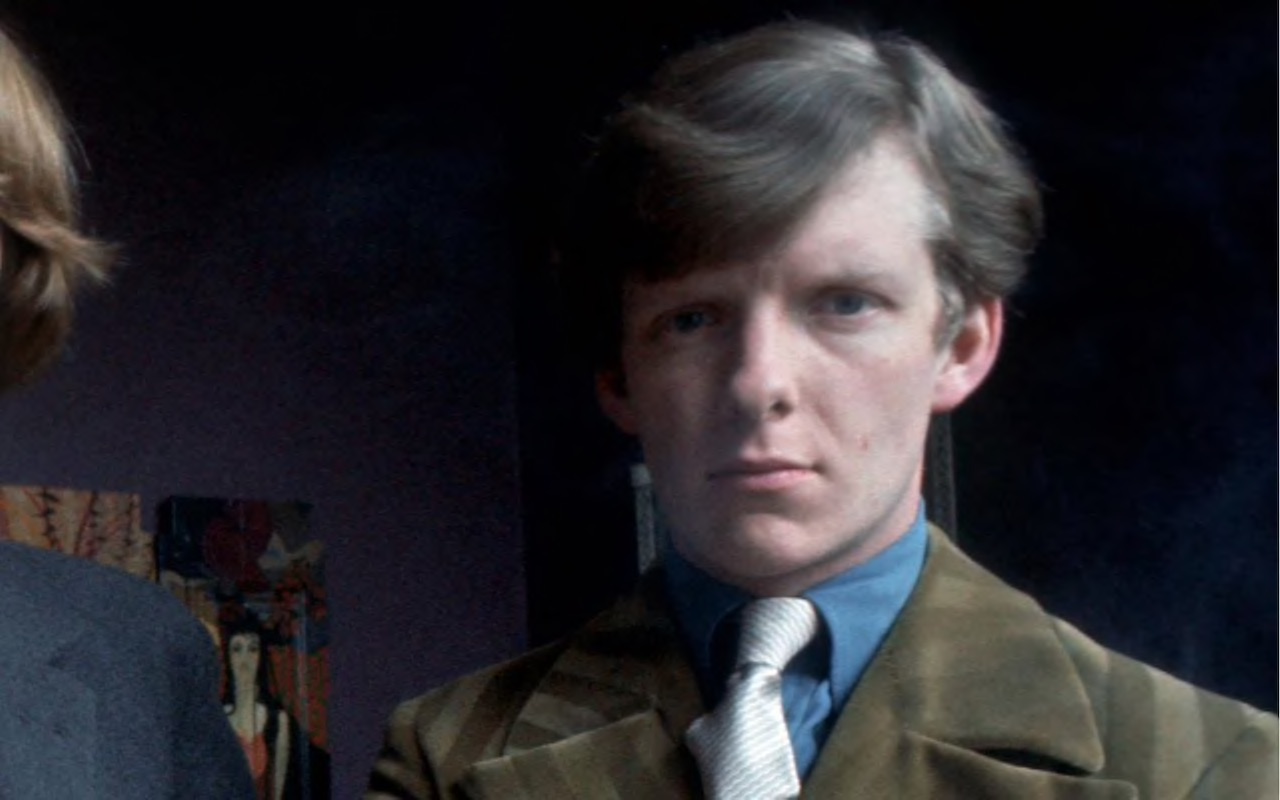
Christopher Gibbs in 1964
Christopher Gibbs, who has died aged 79, was an antiques dealer,
interior designer, bibliophile and aesthete who pioneered a style
of interior decoration often described as “distressed bohemian” –
a mixture of refinement, exoticism and well-worn grandeur.
A typical Gibbs interior might comprise a carefully chosen
assemblage of fine Georgian furniture, threadbare sofas, Chinese
blue-and-white ceramics, antique objets, church hangings, carpets
from the Maghreb and vibrantly clashing cushions and drapes. It
was a look that took years of antiquarian scholarship, poring
through the sales catalogues of auction houses, and eye-watering
prices to achieve. But Gibbs insisted that his aim was “to help
people make nice, cosy homes where they are going to live happy,
beautiful lives” – adding, “No, it’s not tongue-in-cheek. I mean
it.”
A quietly spoken man of considerable erudition and great personal
warmth, Gibbs became the arbiter of taste for a wealthy clientele
that ran the gamut from rock stars to aristocrats, and which
reflected his own extensive social circle. If conversation with
Gibbs could sometimes seem like a Himalayan expedition in name
dropping – be it mention of a famous pop-star, aristocrat, or an
“amusing German prince” (the banker Rupert Lowenstein, whom Gibbs
introduced to Mick Jagger, and who became the Rolling Stones’
business manager), it was because Gibbs did indeed seem to know
everyone.
In 1967 he was among the house-party at the infamous bust at Keith
Richards’s Sussex home, which resulted in the arrest of Mick
Jagger and the art dealer Robert Fraser for possession of drugs.
In the 1980s, he was largely responsible for rousing his friend
John Paul Getty Jr from the torpor in which Getty lay in the
London Clinic, being treated for drug addiction and depression,
and persuading him to make a donation of £40 million to the
National Gallery. In 2012 Gibbs advised and sourced much of the
furnishing for the restoration of Spencer House by his friend
Jacob, Lord Rothschild.
Christopher Gibbs was born on July 29 1938, the fifth son of Sir
Geoffrey Cokayne Gibbs KCMG and his wife Helen. Following in his
father’s footsteps, Gibbs was sent to be educated at Eton, but was
expelled, as he would later recall, “for drinking, panty raids on
other boys’ rooms, that sort of thing …” After attending the
University of Poitiers, and a short spell in the Army, he became
the hub of “the Chelsea Set” – a loose aggregate of young aristos,
public schoolboys and the more racy species of debutantes, who
frequented the Markham Arms in Chelsea, and whose principal
enthusiasms were clothes, inebriation and a rather self-conscious
slumming.
Gibbs was the dandy par excellence; as a 14-year-old at Eton he
had sported velvet slippers, a monocle and a silver-topped cane
with blue tassels and handed out visiting cards. He was said to be
the first person on the King’s Road to wear flared trousers, in
1961, and the first to wear kaftans. “He was very flash,” Nik Cohn
wrote in his book on British style in the Sixties, Today There Are
No Gentlemen. “Sometimes he just wore tight jeans or fancy dress,
like the others; but mostly his tastes were elaborate; suits with
double-breasted waistcoats and cloth-covered buttons, and velvet
ties, and striped Turkish shirts with stiff white collars, and
cravats. Above all, he had a passion for carnations and was
forever buying new strains, pink-and-yellow, or green-ink, or
purple with red flecks.”
In 1958 Gibbs made his first visit to Tangier, returning with a
stock of drapes, hangings and cushions, with which he stocked his
first antiques shop in Chelsea, selling decorative objets and
furniture. Fascinated, as he put it, “by the mixture of the grand
and the raffish and the fast and the chic”, Gibbs became the
aesthetic centre of a group that embodied the socially fluid and
hedonistic mood of Sixties London.
The set included the Rolling Stones (it was said to be Gibbs who
“initiated Mick Jagger into the arcane mysteries of high camp”),
the heir to the Guinness fortune Tara Browne, the men’s fashion
designer Michael Fish and the American avant-garde film director,
occultist and Aleister Crowley enthusiast Kenneth Anger (“He’d
hate me to say it,” Gibbs once remarked, “but Kenneth’s a cosy old
thing.”). Robert Fraser would credit Gibbs as having invented
“Swinging London”.
Gibbs’s Cheyne Walk home became a salon for the hip elite. It was
used by director Michelangelo Antonioni as the set for the party
scene in Blow-Up, and Anger also used Gibbs’s home to shoot some
of the scenes of his infamous masterpiece Lucifer Rising.
In 1968 Gibbs was employed to design the interiors for Donald
Cammell and Nic Roeg’s seminal Sixties film Performance, about a
past-it rock star, Turner, played by Mick Jagger. Cammell had
stipulated that the interiors should be decorated “predominantly
in the Gibbsian Moroccan manner, furnished with strange and
beautiful things,” suffused with a glamorous decay, “the dust in
its crannies of a refined sensibility”. It was the style that
Cammell had employed in designing Brian Jones’s flat in Earls
Court.
Gibbs furnished Turner’s rooms with mats and hangings from
Morocco, a bedspread from the Hindu Kush, a marbled bath with 17th
century Japanese dishes, and tiles designed from a Persian carpet.
“I wanted something mysterious and beautiful and unexpected,
exotic and voluptuous and far away from pedestrian; some hint of
earthly paradise. It also had to be done in four and half minutes
on four and a half pennies.”
An enthusiastic consumer of marijuana and LSD, Gibbs nonetheless
retained a tenacious work ethic. “I definitely suffer from the
blown-mind syndrome,” he told the writer Paul Gorman, recalling
the Sixties. “The only thing I’ll say in my favour is that I was
practically the only person I knew who actually went to work at
nine o’clock in the morning … because I had a job, my own
business, and I realised that, if I didn’t, I wouldn’t have any of
those things.”
For years Gibbs occupied a set in Albany, the most exclusive
address in London, where his friend the writer Bruce Chatwin once
lived in the attic “with a Jacob chair from the Tuileries and the
18th-century bedsheets of the King of Tonga adorning the wall.”
In 1972 he bought a former Benedictine nunnery, Davington Priory
in Faversham, where for three years his houseguest was the
mercurial David Litvinoff, an intimate of Lucian Freud, the Kray
Brothers and the Rolling Stones, who acted as “director of
authenticity” on Performance.
Litvinoff became so intolerable that Gibbs was finally obliged to
move out. Shortly afterwards, Litvinoff killed himself there with
an overdose of sleeping pills. “He left me a note, which I found
three months later, hidden in some shirts,” Gibbs recalled. “He
loved blues music. It said ‘I’ve made eight tapes for you in such
and such a box; please send another tape marked X to somebody in
Australia’. No question of ‘I’m terribly sorry to have been such a
nuisance’ or anything like that.”
Gibbs later sold the house to Bob Geldof, who planned Live Aid
there.
In 1980, following his mother’s death, Gibbs took over his
childhood home, the manor house at Clifton Hampden in Oxfordshire,
which had been built for his family in the 1840s. He sold the
house in 2000, moving to a small cottage on the estate. An auction
of the house’s contents in 2000, which raised £3 million, included
a dining table cut from a slice of wood, thought to be one of the
first pieces of mahogany transported to England from the New World
by Charles II’s navy in the 17th century, and an embroidered
Elizabethan purse that belonged to the first Lord Yarmouth,
treasurer to James II, containing a fragment of the monarch’s blue
silk garter enclosed in a wisp of paper bearing the words, “King
James’s Garter – I touch and God cures’’.
Gibbs was a connoisseur of English church architecture, the
decorative arts, antiquarian books and the gardens of stately
homes. His friend John Richardson, Picasso’s biographer, described
him as being “in the tradition of English cognoscenti – like an
18th-century English parson who knew more about Etruscan vases
than anybody in the British Museum.” He disdained bad manners,
kitsch, the “floridity” of the super-rich, and television sets.
In 2006 he auctioned off the last of his stock at Christie’s and
retreated to Tangiers, where he bought a home overlooking the
city. This he furnished with characteristically eclectic taste
with such items as a mid-17th-century painting attributed to Luca
Giordano, shabby sofas, antique marbled tables and a collection of
whips. While admitting that he sometimes got “homesick for
snowdrops”, Gibbs admired Tangiers as a place, he once said, where
you could feel “the ancient world still kicking along”, and where
his aesthetic sense was tempered by “the basics … Here they can
cheer things up with a bunch of flowers or a small piece of
needlework.”
There he concentrated on cultivating his garden, and his duties as
a church warden at the city’s Anglican church, St Andrew’s. A
visitor to Gibbs’s home noted that “he was wearing wonderful
kaftans, and he looked like Moses walking in the olive garden.”
He never married.
Christopher Gibbs, born July 29 1938, died July 28 2018
 Vogue July 31
2018 - Hamish Bowles Remembers Christopher Gibbs, The
Quintessential British Dandy and Tastemaker to Generations
Vogue July 31
2018 - Hamish Bowles Remembers Christopher Gibbs, The
Quintessential British Dandy and Tastemaker to Generations
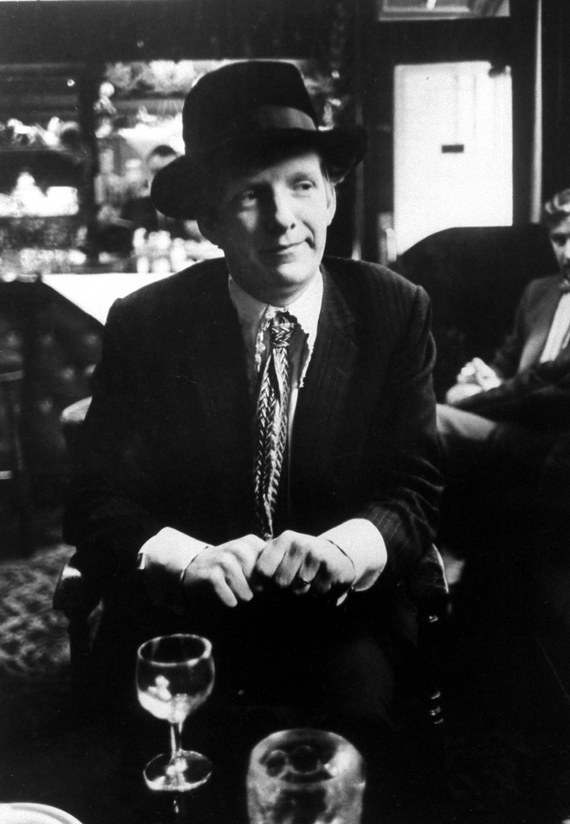
Christopher Gibbs, 1966
“Taste is difficult to define,” opined Min Hogg, the exigent
founding editor of World of Interiors, “but his is absolute
perfection.” She was talking of her great friend Christopher
Gibbs, tastemaker extraordinaire, who has died on the cusp on his
80th birthday.
The fifth son of the Hon. Sir Geoffrey Cockayne Gibbs, KCMG and
his wife Helen Margaret Leslie CBE, Christopher Gibbs was a
well-born Renaissance man with an unmatched eye for aesthetics and
a talent for friendship and the mot juste. His weighty words were
dispensed with the effortless elegance that he applied to all
aspects of his life, from faith to clothing, to collecting and to
romance, as he reached for a turn of phrase that could be by turns
Firbankian, Mitfordian, or Hogarthian. He was expelled from Eton
for Rabelaisian antics—“illicit drinking, panty raids of other
boys’ rooms—that sort of thing,” as he wryly recalled, and later
attended the University of Poitiers, followed by a brief stint in
the army.
But it was a trip to Morocco that was to prove an epiphany. There
he discovered the “chimeric city” of Tangier. “I was a young
fellow,” he told The New York Times, “and I came in the spring
with an old-fashioned friend who had letters of introduction.” It
was, as he discovered “a mystic hangover,” a place where “the
ancient world [was] still kicking along.”
After that first Tangier foray, Gibbs returned to London laden
with Moroccan textiles and rugs and beautifully hand-crafted
objects with which he stocked his first antiques emporium on
Sloane Avenue. He was 20.
At a time when penurious aristocrats were still demolishing
unwieldy stately homes or at least divesting them of some of their
contents, the well-connected Gibbs was uniquely placed to sleuth
and gather the spoils and market them with seductive style to a
generation of deep-pocketed fellow trendsetters, from a gaggle of
Gettys and Lord Rothschild to Bryan Ferry and Mick Jagger (who
hung out with him, as he once playfully confessed, “to learn how
to be a gentleman”).
Gibbs’s avowed aim, as he modestly noted, was to “help people make
nice cosy homes where they are going to live happy, beautiful
lives.” In fact, he shaped the taste of a generation, appreciating
the potency of provenance and patina, and handling scale like no
one else. He venerated the splendid and the curious and the humble
in equal measure—aesthetic beauty and craftsmanship and the love
that had been expended on objects were what attracted him, and he
set the bar for generations of insatiable collectors and
aesthetes. A visit to his emporium was invariably a lesson in
history. His erudition was astonishing, “in the tradition of
English cognoscenti,” as his friend Sir John Richardson noted,
“like an eighteenth century English parson who knew more about
Etruscan vases than anyone at the British Museum.” Above all, he
disdained the ‘floridity” of opulent taste; Tangier, he averred,
had taught him the beauty of “simplicity.”
In a Gibbs scheme a console of writhing old golden volutes hauled
back from a Grand Tour by some eighteenth century English
aristocrat for his Palladian palace (and still bearing its
original age-dulled and flaking flinish) would be juxtaposed with
pots made by villagers in the Rif mountains where he built a
bewitching adobe retreat. Damasks were faded, silk velvet was
balding, a grand Victorian club chair (once doubtless home to some
distinguished writer or politician’s sturdy bottom) would be so
threadbare it was practically spilling its horsehair innards,
garden flowers were arranged more or less as they fell. “I like
things in their natural state,” he once explained, “people
especially…objects and people that are unmonkeyed with, that are
themselves, not trying to be something else.”
“Part Montesquieu, part Beau Brummel, and part Baudelaire,” Gibbs
was at the throbbing heart of Swinging London, attracted, as he
recalled to “the grand and the raffish and the fast and the chic,”
although he always understood that hard work was the only thing
that would sustain and support his passion for beautiful people
and things. He knew and was in turn beloved by a who’s who of the
great style-makers of the 20th and 21st centuries.
His Cheyne Walk flat was the setting for the marijuana party scene
in Antonioni’s Blow Up, (“I thought you were supposed to be in
Paris,” an irate David Hemmings— as a character based on David
Bailey—says to the period’s uber model Veruschka. “I am in Paris”
she replies, apparently stoned out of her mind). Kenneth Anger
also shot some scenes for his 1971 cult classic Lucifer Rising
there. Gibbs defined the look of Swinging London in the haute
boheme setting that he designed for Nicolas Roeg’s 1970
Performance starring Mick Jagger, Anita Pallenberg, and James
Fox—sets that exemplify his signature hippie de luxe mix of vastly
scaled antiques, quirky objects, and Moroccan textiles. “I wanted
something mysterious and beautiful and unexpected,” he explained,
“exotic and voluptuous and far away from pedestrian: some hint of
earthly paradise.” It could describe any of the magical
environments that he created for himself.
If it was happening in the ’60s, Gibbs was there: he was at the
party where the Stones were busted and Marianne Faithful was
cavorting with a Mars Bar, and he took the band to Tangier where
they hung out at the louche Café Hafa and discovered the unique
cadences of indigenous Moroccan music. When he hosted a fashion
show for Janet Lyle and Maggie Keswick’s fashion house of Annacat
in his Regency flat in 1967 beauteous British aristocrats modeled
the clothes in his tapestried drawing room before the gratin of
with-it society: David Bailey brought Catherine Deneuve, Marianne
Faithful simpered, and Private Eye’s editor John Wells read the
order of show to the accompaniment of Dudley Moore at the piano.
Gibbs was the quintessential dandy. He is credited as the wearer
of the first flared pants for men (in 1961), of flowering
patterned shirts and Regency revival jackets and Moroccan caftans,
and was the poster boy for his friends’ menswear fashion brands
(including Michael Rainey’s Hung on You, Rupert Lycett Green’s
Blades, and Nigel Waymouth, Sheila Cohen, and John Pearse’s Granny
Takes a Trip). Gibbs confessed to being “monumentally
narcissistic” at the time, and recalled that he might spend 40
minutes on the phone with friends discussing which particular tie
(kipper-wide, from Mr. Fish), to wear that day. In the latter half
of the ’60s Gibbs parlayed his sartorial know-how as the editor of
the shopping guide in the quarterly Men in Vogue supplement of
British Vogue. In later life his grand bespoke finery was as
loved, well-worn, and battered as the objects he revered, and in
Morocco his caftans and lemon leather babouche slippers gave him
the appearance of a biblical seer.
Gibbs later exercized his interior taste in a set at Albany, the
storied apartment building built around the 1774 mansion designed
by Sir William Chambers for Lord Melbourne. A stone’s throw from
London’s Piccadilly Circus, and “the enticements of Soho, the
grandeur of St. James’s, [and] the comforts of Mayfair, to say
nothing of the canny tailoring of Savile Row,” it was, as Gibbs
noted, a place famed for its archaic house rules (“no pets, no
children, no whistling, no noise, and absolutely no publicity”).
It was the perfect London perch, and here Gibbs joined a roster of
past and present incumbents that has included Lord Byron, Baroness
Pauline de Rothschild, Isaiah Berlin, Terence Rattigan, Bruce
Chatwin, Sybille Bedford, Terence Stamp, Aldous Huxley, Fleur
Cowles, David Hicks, Garbo, and a fistful of prime ministers from
Gladstone to Thatcher.
By 1972 his success as a dealer of beautiful treasures was such
that he acquired rambling Davington Priory, a former Benedictine
nunnery built in 1153 in the English county of Kent. In 2000, with
great reluctance, he sold his family house in Clifton Hampden in
Oxfordshire and its contents in an epic sale at Christie’s (“it’s
quite a caper to keep a place like this going”), and retreated to
his Tangier homes.
He acquired El Foolk, the house of the beauteous artist Marguerite
McBey, a Philadelphian heiress who had created a farmhouse on
Tangier’s Old Mountain that would not have been out of place in
the Sussex Downs and commanded breathtaking views across the
Straits of Gibraltar to the coast of southern Spain. Gibbs opened
a double doorway from the living room into her former studio, but
otherwise kept the atmosphere intact and amplified it with a
layering of even more precious and idiosyncratic objects. With his
godson, the architect Cosimo Sesti, he later built a ravishing
Neoclassical villa in the neighboring gardens, and worked with
fellow aesthete Umberto Pasti to create new gardens of imposing if
always insouciant charm that soon grew to fecund splendor.
This new house, with its soaring volumes, was a showcase for
Gibbs’s bravura if nonchalant taste. The drawing room’s walls were
dappled in lime-wash the color of pulped tomatoes by a feisty
Frenchwoman who came up from Marrakesh expressly for the purpose;
underfoot lay a Tuareg straw and leather carpet. The room’s great
height was emphasized by a vast and handsome painting,
convincingly attributed to Luca Giordano, of “Hercules hoisting
the giant Antaeus,” in its original frame of chunky scrolls of
ebonized and gilded wood (the Caves of Hercules are to be found
just outside the city of Tangier). It hung above an Indian Regency
sofa with a faded pink linen cover hidden beneath an embarrassment
of cushions worked with Fez embroidery. Gibbs’s study was
essentially a conservatory that brought the sublime gardens
inside. “If you have a garden and you experience it through the
seasons,” he confided, “it holds you for life.” Gibbs’s partner in
life was the sumptuously beautiful Peter Hinwood who lived in his
own modest house in the gardens of the El Foolk property.
Possessed of very distinguished taste himself, through the decades
Hinwood has enjoyed careers as a model, (notably cast as a
motorbiking Lothario for an iconic ’60s Olivetti commercial), an
antique dealer of consummate refinement, and as an actor,
memorably portraying the original Rocky in The Rocky Horror Show,
clad in the briefest gold lamé shorts and muscle magazine
abdomens.
Gibbs was a pillar of the quaint church of Saint Andrews, built at
the turn of the century on the fringes of Tangier’s Grand Socco—“a
cool oasis in the city,” as he noted, “with texts from the Koran
woven into the reredos and the Lord’s prayer in Arabic round the
chancel arch. Its very existence—built by the Scots, painted by
Matisse— encourages a belief in miracles.” Gibbs’s faith was deep
and sustaining and was made manifest in his profound kindness and
generosity of spirit.
Gibbs was a pillar of the quaint church of Saint Andrews, built at
the turn of the century on the fringes of Tangier’s Grand Socco—“a
cool oasis in the city,” as he noted, “with texts from the Koran
woven into the reredos and the Lord’s prayer in Arabic round the
chancel arch. Its very existence—built by the Scots, painted by
Matisse— encourages a belief in miracles.” Gibbs’s faith was deep
and sustaining and was made manifest in his profound kindness and
generosity of spirit.
Christopher Gibbs died like a king of yore, in his beloved house
in his beloved Tangier, surrounded by friends, family, and devoted
retainers, in a room filled with auction catalogues and commanding
views across the orchard of datura and pomegranate trees that he
had planted and seen grow to fruition, the roiling Straits of
Gibraltar beyond, and the skies above the bright plumbago blue of
his eyes, those all-seeing eyes that had defined taste for half a
century and more.
 Architecural
Digest - Remembering Christopher Gibbs
Architecural
Digest - Remembering Christopher Gibbs
The arbiter of bohemian style died this weekend
 Christopher Gibbs, who died in Tangier,
Morocco, on Saturday, his 80th birthday, bestrode the aesthetic
world like a rock star, and not just because his clients and
friends were literally rock stars—among them, a very young Mick
Jagger, who once confided to a fellow guest at a dinner party
hosted by Gibbs, “I’m here to learn how to be a gentleman.” That
level of celebrity might come as a surprise, given that Gibbs was
an antiques dealer, not typically known as a glamorous career
choice, but he was something quite a bit more rarified than a
purveyor of beloved old things. He was a broodingly handsome,
wittily eloquent man whose quirky, funky, exotic, counterculture
taste, and vast curiosity influenced a generation of individuals
who fell passionately in love with what The New York Times once
called his “distressed bohemian style.”
Christopher Gibbs, who died in Tangier,
Morocco, on Saturday, his 80th birthday, bestrode the aesthetic
world like a rock star, and not just because his clients and
friends were literally rock stars—among them, a very young Mick
Jagger, who once confided to a fellow guest at a dinner party
hosted by Gibbs, “I’m here to learn how to be a gentleman.” That
level of celebrity might come as a surprise, given that Gibbs was
an antiques dealer, not typically known as a glamorous career
choice, but he was something quite a bit more rarified than a
purveyor of beloved old things. He was a broodingly handsome,
wittily eloquent man whose quirky, funky, exotic, counterculture
taste, and vast curiosity influenced a generation of individuals
who fell passionately in love with what The New York Times once
called his “distressed bohemian style.”
“I'm not interested in creating a dazzling impression of
richness,” he told The Guardian. “We can make do with
surprisingly little in life. It is best to have a few things which
are really nice. I don't approve of the mean look, but I do
approve of the spare look, where every little bit is telling.”
Some of the finest bohemians in the Age of Aquarius sprang from
posh backgrounds, and Gibbs, as a grandson of a knight, son of a
baronet, and a descendant of Blessed Margaret Pole, Countess of
Shrewsbury, the martyred Plantagenet heir to the English throne,
was a prime exemplar. An ancestor established the family fortune
by founding a successful London trading company in the 18th
century, and an uncle became governor-general of Southern
Rhodesia. Known far and wide as Chrissie or Dibbley, Gibbs threw
himself not into commerce or politics—he had been expelled from
Eton, he revealed, because of “illicit drinking, panty raids of
other boys’ rooms, that sort of thing”—but into dandyism, becoming
a Beau Brummel of his generation while also operating a buzzy
little antiques shop that he opened in 1958 at the tender age of
20. “Being a shopkeeper, I used to sell things sometimes,” said
Gibbs, who stocked Moroccan garments and textiles and the like
before expanding his stock into atmospheric antiques. “Then I used
to parade around in them.” As he told Life magazine in 1961, he
“encouraged friends to dig into their heirlooms, to wear old
clothes, to turn their backs on ugliness and conformism.”
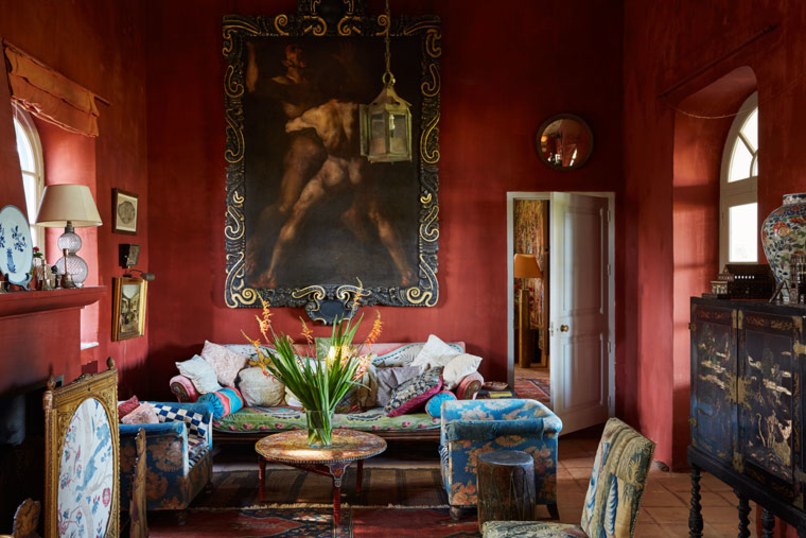
A heroic 17th-century Italian painting, Fez
needlework cushions, an Anglo-Indian sofa, and a splash of
flowered chintz outfit the living room of El Foulk, Gibbs'
Tangier residence, captured by Miguel Flores-Vianna in his book
Haute Bohemians.
All that peacocking led to the so-called King of Chelsea being
hired to be editor in chief of Men in Vogue, a job that
allowed him to cover the sartorial, social, and swinging lives of
his circle of finger-snapping, hashish-smoking, LSD-dropping,
snake-hipped dandies, a heady brew of toffs, entertainers,
socialites, bright young things, and kohl-eyed sirens of both
sexes, from J. Paul Getty Jr. to Marianne Faithfull (which
explains why, later in life, biographers and historians relied on
his memories of that fertile, fantastic period he called “a time
of experiment, dope-fueled and acid-elevated”). He was painted
bare-chested by Patrick Procktor, photographed broodingly by Lord
Snowdon and David Bailey, and loved devotedly by Peter Hinwood,
the blond Adonis of The Rocky Horror Picture Show, who
became Gibbs’s life and business partner as well as an enormously
admired dealer and designer himself. “A man of great, great taste,
almost better than the master,” says AD100 interior designer Veere
Grenney, a part-time Tangerine and close friend, about Hinwood,
who, along with several nieces and nephews, survives Gibbs. The
dealer will be buried on Wednesday, August 1, at the cemetery of
the Church of St. Andrew in Tangier, following a funeral that,
appropriately enough, Grenney says will incorporate “Islamic
elements plus be in the Anglican tradition.”
Gibbs also created sets for the 1970 cult Nicolas Roeg/Donald
Cammell crime-drama Performance, which starred Jagger. “I
got a lot of things from Tangier,” the dealer explained in an
interview for Christie’s.“We had things made and sent over in a
hurry – materials both old and new. There was a lot of sleuthing
around the film hire places, sourcing what might help knit
together and work in the whole picture. The most complicated thing
was making the tiled wall in the bathroom, inspired by a
16th-century garden carpet in the V&A; it made the perfect
backdrop to the bathtub frolics.… The bed for example was based on
the story of the Princess and the Pea; many mattresses on top of
one another, and a mighty stack in multi-coloured velvets was made
and trundled north from Morocco.” His passion for the North
African kingdom had begun with a trip there in 1958, and he
remained enthralled by zellige, tadelakt, and Berber carpets for
the rest of his life, even though, as he once admitted, souk chic
had become a bit old hat.
His apartment at 100 Cheyne Walk, a seductively louche magnet
for London’s hip set, appeared in Michelangelo Antonioni’s Blow-Up
and Kenneth Anger’s Lucifer Rising. “The [drawing] room
was dominated by an enormous painting by Il Pordenone that had
previously belonged to the duc d’Orléans,” a biography of William
S. Burroughs, a Gibbs intimate, recounts. “A huge Moroccan
chandelier cast a thousand pinpoints of light over Eastern
hangings and silk carpets. In the summer, afternoon tea was taken
under the mulberry tree in a garden designed by Lutyens.” Cheyne
Walk was also where Gibbs hosted a famous party for Allen
Ginsberg, which Princess Margaret attended. So did Talitha Pol
(Mrs. J. Paul Getty Jr.) in a see-through dress that revealed a
total lack of undergarments. Unexpectedly powerful hashish
brownies (the recipe came from The Alice B. Toklas Cook Book)
were among the hors d’oeuvres, and Her Royal Highness ended up in
hospital with what was blamed on “severe food poisoning.”
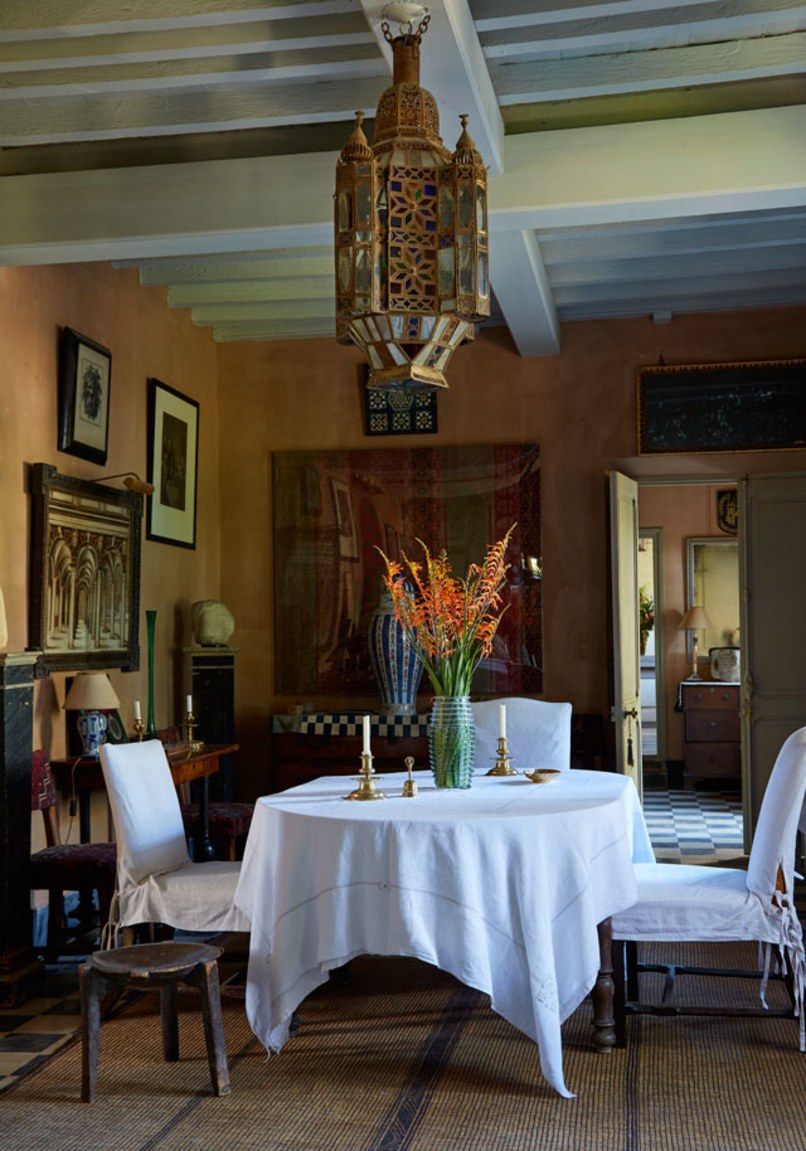
Gibbs' Tangier dining room in a photograph by
Miguel Flores-Vianna from Haute Bohemians.
Though AD once described Christopher Gibbs Ltd. somewhat
blandly—“Eclectic and unusual items from the 17th century through
the 1960s”—it was, Canadian interior designer Colette van den
Thillart has recalled, “a Kunstkammer filled with the most
astonishing wonders…a vibrant yet gloomy forest of beauty.” It was
the sort of place one could find anything from a 19th-century
American whip that once belonged to Lord Rosebery (“It was
probably used for whipping slaves,” Gibbs blandly observed) to
what Manhattan decorator David Easton called “large eccentric
furniture,” such as a pair of 20th-century sofas copied from a
grandiose design by 18th-century architect William Kent or
bookcases so immense that they required a castle to suit them
properly. One could find Jagger poking around as readily as one
could glimpse Bill Blass, Pauline de Rothschild, or Lincoln
Kirstein; one of the salesmen, appropriately enough, had been
Bulent Rauf, the Turkish mystic. Simon Wells, in his book Butterfly
on a Wheel: The Great Rolling Stones Drug Bust, twigged
Gibbs’s taste perfectly, defining his haute-hippie chic as
“well-worn grandeur with vibrant treasures from Asia, the Middle
East, and Africa, particularly Morocco. Aware that much of Middle
Eastern art and decor resonated strongly with the psychedelic
experience, Gibbs was a much sought-after expert when pop people
turned their attention to decorating the interiors of their flats
and houses.” Jagger relied on Gibbs to decorate multiple houses
for him, having fallen completely under the dealer’s spell; Lord
Rothschild and Paul Mellon were fans too.
“It was a memorable experience to leave the hustle and bustle of
Bond Street, pass through that narrow darkened passage, to burst
into the high, top-lit treasure house of salivation,”
architectural historian John Harris recalled of Gibbs’s shop.
“Here would be found the genial and constantly creative Peter
Hinwood, one of whose roles was aesthetic arrangement and
juxtaposition, what one might call the shaking of the
kaleidoscope. I was always aware of how object answered object in
many sensitive ways, and there was always what might be called
creative rearrangements. I suppose the exhibit that evoked gasps
from all and sundry was Lord Iveagh’s sock cabinet from his
bedroom at Elveden Hall, Suffolk; its drawers still containing an
array of smelly socks wrapped around Sir William Chambers’s
designs for the cabinet, no less than the medal cabinet designed
for Lord Charlemont at Charlemont House, Dublin.”
Photographs of Gibbs’s residences, from Davington Priory in
Oxfordshire to El Foulk in Tangier, which was featured in Miguel
Flores-Vianna’s book Haute Bohemians, were widely studied,
ravishing more than one generation of admirers. Each home was a
shrine, Christopher Mason wrote in The New York Times in
2000, to the dealer’s “elusive brand of anti-decoration,
high-bohemian taste favored by self-confident Englishmen, a look
based on well-worn grandeur, disarming charm, and unexpected
contrasts. The magic is in the mix of masterpieces and
oddities—like an assemblage of refined and wild-card house guests
who mysteriously combine to create the ideal convivial
country-house weekend. The allergy here is to the banal, not to
dust.”
Gibbs reveled in a lifelong “delight in quirky objects whether humble or precious,” Hamish Bowles of Vogue posted on Instagram shortly after hearing about his garrulous, inquisitive friend’s demise from cancer. Nearly everything in the shop had a story attached to it, leading The New York Times to declare its owner a “provenance fetishist.” Gibbs happily concurred, saying, “I like intrinsically beautiful things, but if there's a yarn attached, that's a big plus.” Wear and tear was welcomed, even preferred: gilding worn to the quick, carpets closing in on the threadbare. “I like things in their natural state—people especially,” Gibbs told Mason. “Objects and people that are unmonkeyed with, that are themselves, not trying to be something else.”
The shop, to howls of protest, closed more than a decade ago,
after Gibbs decided to move permanently to Tangier, as much
because of his advancing age as for changes in popular taste,
which he politely decried. Collectors today “want a good car, a
good sound system, and a huge pink heart painted by Damien Hirst
with dying butterflies on it which costs £400,000,” he said,
plainly puzzled. “Yet for much less you could buy something
completely fascinating made 300 years ago.”
 House &
Garden - Unforgettable advice from the late, great antiques dealer
& aesthete Christopher Gibbs, who died on Sunday
House &
Garden - Unforgettable advice from the late, great antiques dealer
& aesthete Christopher Gibbs, who died on Sunday
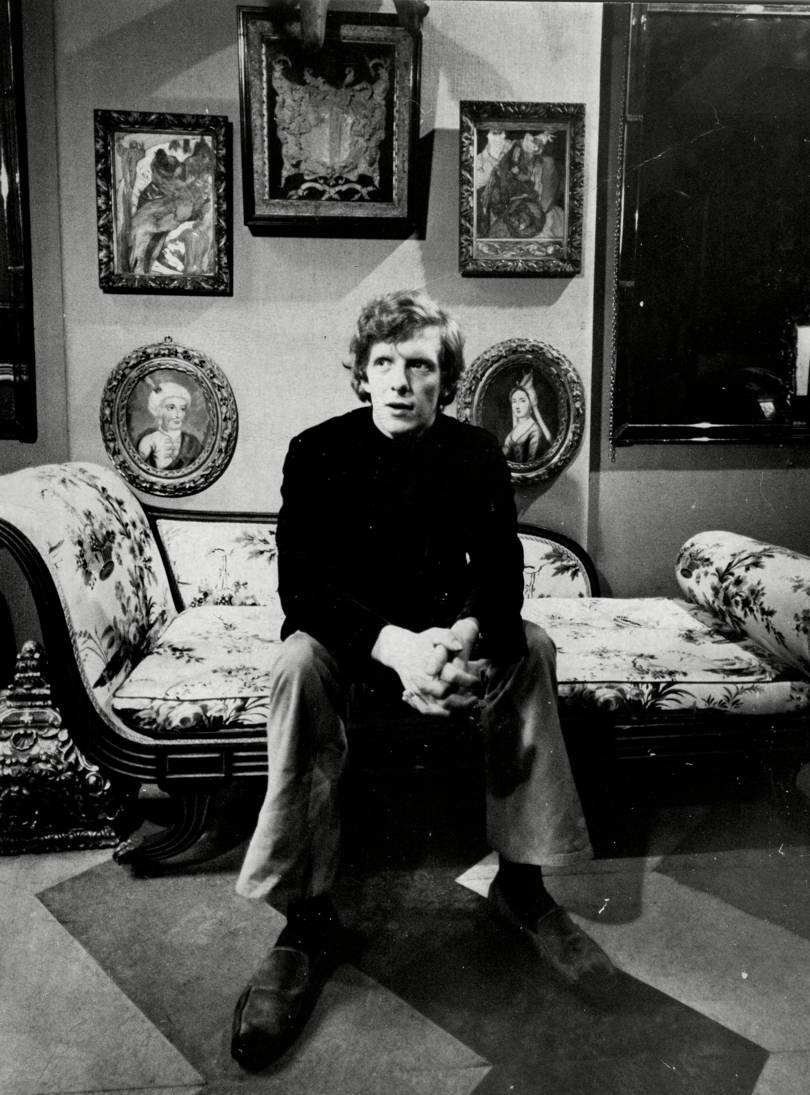 Described by the Telegraph as ‘the great civilising
influence of the high 1960s counterculture,’ tributes have been
pouring in for the late collector, antiques dealer, bibliophile
and tastemaker Christopher Gibbs, who died yesterday in Tangier.
Expelled from Eton for conning the local antiquarian bookseller
into buying back its own stock, Gibbs set up his first antiques
shop in Islington just as Sixties London was beginning to swing.
Forming part of a group of socialites, fashion designers and
flamboyant pop stars, who are now the stuff of cultural legend,
his set, which included the Rolling Stones, re-invented the idea
of dandyism, and made the English home cool again.
Described by the Telegraph as ‘the great civilising
influence of the high 1960s counterculture,’ tributes have been
pouring in for the late collector, antiques dealer, bibliophile
and tastemaker Christopher Gibbs, who died yesterday in Tangier.
Expelled from Eton for conning the local antiquarian bookseller
into buying back its own stock, Gibbs set up his first antiques
shop in Islington just as Sixties London was beginning to swing.
Forming part of a group of socialites, fashion designers and
flamboyant pop stars, who are now the stuff of cultural legend,
his set, which included the Rolling Stones, re-invented the idea
of dandyism, and made the English home cool again.
His work was beautifully defined by Christopher Manson in a 1990’s
profile in the New York Times; ‘He is the leading proponent of
that that elusive brand of anti-decoration, high-bohemian taste
favoured by self-confident Englishmen, a look based on well-worn
grandeur, disarming charm and unexpected contrasts.’ In tribute
we’ve unearthed our favourite Christopher Gibbs quotes. Timeless
advice which will stand for generations to come.
"We have got to the extraordinary moment when everything is
held to have a value, 'I'm a great chucker-out. I go into
people's homes and say: 'Chuck it out, chuck it out'. They say:
'But I won't have anything to sit on'. I say: 'Sit on the floor,
then, until you find the right thing'.'
'As life goes by, that's what I admire. Objects and people
that are unmonkeyed with, that are themselves, not trying to be
something else.'
‘Following your nose. Finding out who the best merchant
is. Sleuthing round sale rooms. Then only buy the things you're
really turned on by.’
'I love to bring light into gloom. Even dark-panelled rooms
can come leaping into life with the help of Chinese
blue-and-white ceramics or a refreshing Meissen sculpture.'
'I try to find things for my clients which I have never
seen before, which they have never seen before and which neither
of us are likely to see again. I might see beauty in strange
things, strange beings, strange places.'
Most old stuff is rubbish. And lots of it is hideous. But
if you want to buy a nice table or desk, it's only a few hundred
pounds - not more than a thousand.'
'They all want to be like everyone else. They want a good
car, a good sound system and a huge pink heart painted by
Damien Hirst with dying butterflies on it which costs
£400,000. Yet for much less you could buy something completely
fascinating made 300 years ago.'
 The New
York Times - Christopher Gibbs, Avatar of ‘Swinging London,’ Dies
at 80
The New
York Times - Christopher Gibbs, Avatar of ‘Swinging London,’ Dies
at 80
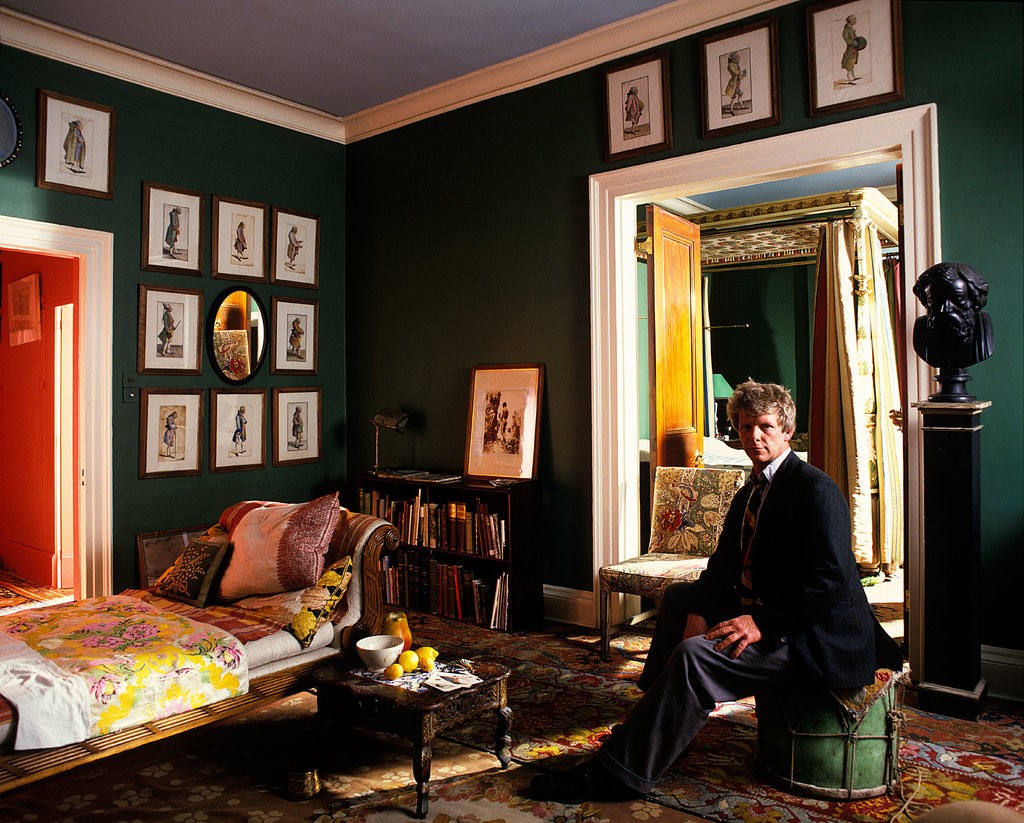
Christopher Gibbs, the antiques dealer,
interior designer and fashion avatar, at his London home in an
undated photo. He helped establish the “distressed bohemian”
aesthetic.
Christopher Gibbs, an erudite London antiques dealer and dandy
who introduced the raffish “distressed bohemian” style to interior
design and helped start the Peacock Revolution in men’s wear, died
early Sunday at his home in Tangier, Morocco. Only minutes
earlier, at midnight, he had turned 80.
Cosimo Sesti, an architect and Mr. Gibbs’s godson, said in a
telephone interview from Tangier that the cause was respiratory
and cardiac failure.
Said to be a descendant of Margaret Pole, the executed
16th-century Plantagenet heiress to the English throne, Mr. Gibbs
was an aristocratic lodestone for rock stars like Mick Jagger
(“I’m here to learn how to be a gentleman,” Mr. Jagger was quoted
as saying after visiting Mr. Gibbs at his home), John Paul Getty
Jr. (whom Mr. Gibbs persuaded to donate $40 million to the
National Gallery in London), the Beat Generation novelist William
S. Burroughs; and Prince Rupert zu Loewenstein of Bavaria, a
banker who became the Rolling Stones’ business manager. They were
all clients of his or guests at his salons.
Mr. Gibbs had a reliable formula for surviving as a society
stylemaker in the 1960s. As he confided to Paul Gorman in his book
“The Look: Adventures in Pop & Rock Fashion” (2001), “you had
to be monumentally narcissistic and have time on your hands, and
just about enough money to do it.”
But Mr. Gibbs had more going for him than that. Unlike many of
his decadent mates, Mr. Gibbs was wise, worldly and endowed with
both a work ethic and a refined if finicky taste that was
undiminished by his extensive experimentation with drugs or his
predilection for exotica, like a stuffed, two-headed lamb and a
collection of whips.
“He is also a leading proponent of that elusive brand of
anti-decoration, high-bohemian taste favored by self-confident
Englishmen, a look based on well-worn grandeur, disarming charm
and unexpected contrasts,” Christopher Mason wrote in The New York
Times in 2000.
“The magic,” he added, “is in the mix of masterpieces and
oddities — like an assemblage of refined and wild-card house
guests who mysteriously combine to create the ideal convivial
country-house weekend. The allergy here is to the banal, not to
dust.”
As Mr. Gibbs himself put it: “I like things in their natural state
— people especially. As life goes by, that’s what I admire:
objects and people that are unmonkeyed with, that are themselves,
not trying to be something else.”
In 1960s Swinging London, the people who aspired to the hedonistic
set were habitually trying to be like him.
As a clothes horse himself and also while editing the shopping
guide of the quarterly Men in Vogue magazine from 1965 to 1970,
Mr. Gibbs was credited with popularizing flared trousers, caftans
and print shirts.
His eclectic taste in objects leaned toward elegant mahogany and
marbled tables, shabby sofas, faded damasks and a sock cabinet
that was designed by Sir William Chambers and that belonged to the
first Earl of Iveagh (smelly socks included). Taste, he once
suggested, could not be taught.

Mr. Gibbs, right, with his friends Mick Jagger and Marianne
Faithfull in Dublin in 1967. Taste, he said, is “something you
catch, like measles or religion.”
“It’s something you catch,” he said, “like measles or religion.”
His objects of desire filled his Cheyne Walk home in London, which
was borrowed by Michelangelo Antonioni for the party scene in his
movie “Blow-up” (1966) and by Kenneth Anger to shoot the occult
film “Lucifer Rising” (1972).
Mr. Gibbs also designed what he called the “earthly paradise”
inhabited by the has-been rock star played by Mick Jagger in
Donald Cammell and Nicolas Roeg’s film “Performance” (1970).
“Christopher was almost single-handedly responsible for making
English antiques, and English heritage, look ‘cool’ again,” James
Reginato, writer-at-large for Vanity Fair, said in an email.
Mr. Gibbs’s London manor, which once belonged to the painter James
McNeill Whistler, was also the scene of a party for the poet Allen
Ginsberg, where the hors d’oeuvres included a batch of
industrial-strength hashish brownies. According a biography of Mr.
Jagger by Christopher Andersen, the socially active Princess
Margaret was among the guests who were hospitalized that night
with what was diagnosed as food poisoning.
Christopher Henry Gibbs was born on July 29, 1938, in Hatfield,
about 20 miles north of London, to Sir Geoffrey Cokayne Gibbs and
Helen Margaret (Leslie) Gibbs.
Even as a 14-year-old Etonian, he affected velvet slippers, a
monocle and a silver-topped cane with blue tassels. A year later,
he was expelled, as he later explained unapologetically, for
“illicit drinking, panty raids of other boys’ rooms — that sort of
thing.”
After studying, according to various biographies, at the Sorbonne
and the University of Poitiers in France and lasting three months
in the British army (he had polio as a child and was soon found to
be medically unfit), his mother in 1958 staked him to a goodly sum
(about $225,000 in today’s dollars) when he was 20 to open an
antiques dealership in Chelsea.
That same year he began making buying trips to Morocco to scope
out brass lamps, carpets and other merchandise for his store and
his clients.
Mr. Gibbs played hard, but worked hard, too.
“The only thing I’ll say in my favor,” he recalled, “is that I was
practically the only person I knew who actually went to work at
nine o’clock in the morning, whether I’d been up to eight o’clock
or not, because I had a job, my own business, and I realized that,
if I didn’t, I wouldn’t have any of those things.”
In 1972 he bought Davington Privy, a 12th-century former convent
in Kent. After his mother died in 1980, he also took over his
childhood home, the 19th-century manor house at Clifton Hampden in
Oxfordshire. He sold it in 2000 after his 90-year-old housekeeper,
Louise Wagland, the only other occupant, died.
He moved full time to Tangier in 2006, where he lived with his
partner, Peter Hinwood, who survives him. There he served as
warden at the Anglican Church and tended his orchard of
pomegranate trees and poisonous plants on a slope overlooking the
Strait of Gibraltar.
He admitted to sometimes getting “homesick for snowdrops,” but to
Milly de Cabrol, a New York interior designer who visited him in
2000, he had acquired the look of the very things he liked — of
someone in his “natural state” — as he surveyed the breathtaking
vista in his flowing caftan.
“He looked like Moses walking in the olive garden,” she said,
“very peaceful, and looking forward to spending more time there.”
 EuroBishop -
Christopher Gibbs RIP
EuroBishop -
Christopher Gibbs RIP
Bishop David Hamid for the Church of England Diocese in Europe.
 Christopher Gibbs, one time Churchwarden of St Andrew's Tangier, and a
key lay leader in the congregation for many years has died in the city
he loved just one day before his 80th birthday. He called Tangier a
“chimeric place”, presumably as it seems almost like a creature, pieced
together from so many cultures, peoples, and influences. A perfect place
for the antique collector Christopher to make his home. His funeral was
today in St Andrmythicalew's and he was buried in the churchyard.
Christopher Gibbs, one time Churchwarden of St Andrew's Tangier, and a
key lay leader in the congregation for many years has died in the city
he loved just one day before his 80th birthday. He called Tangier a
“chimeric place”, presumably as it seems almost like a creature, pieced
together from so many cultures, peoples, and influences. A perfect place
for the antique collector Christopher to make his home. His funeral was
today in St Andrmythicalew's and he was buried in the churchyard.
Known to many as a friend of rock stars and of many of the world's rich and famous, and even having been attributed with the invention of “swinging London”, Christopher's great love in latter years was the Church of St Andrew. He adored its quiet beauty inspired by Moorish tradition, and was proud that it was a gem which the great Matisse was moved to paint. Christopher loved the people of St Andrew's and had a particular generosity of heart towards the newest parishioners, the many from sub-Saharan Africa, who have made this Church their home and who find comfort and hope in this spiritual oasis. Christopher was deeply moved by the stories of those who have migrated here from lands to the south, and was impressed with the faith and dignity of St Andrew's African parishioners whom he described warmly as “chic, graceful and brave”. Despite a great distance in upbringing and culture, Christopher believed the truth that God calls us all to be one family, and thus he felt at home in St Andrew's with his African sisters and brothers.
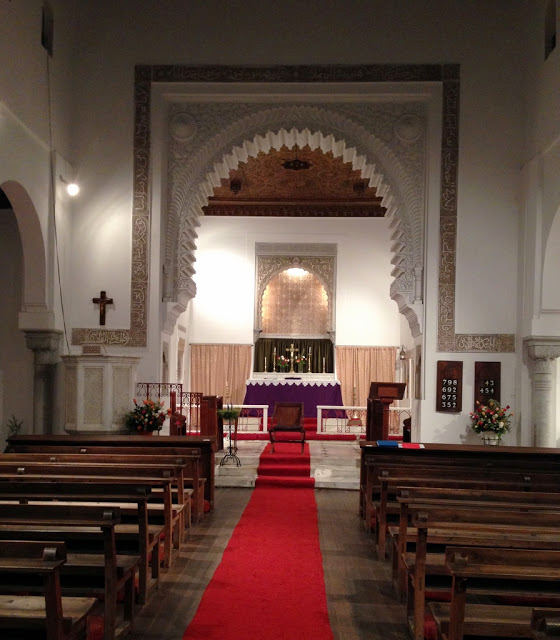
As a Churchwarden for so many years, Christopher was a supporter and friend to the priests who have served here over the years. It is Christopher’s vision that has helped St Andrew’s move to its present phase of its life, after so many years of locum chaplains, but now served by a permanent resident priest. It was with Christopher's bold encouragement to me as bishop that I sought a priest for St Andrew's, Fr Dennis Obidiegwu, who would be able to relate to the diversity of the parish.
Tangier now mourns one of her beloved residents. St Andrew’s mourns the passing of a dear brother, friend and mentor. We entrust our companion in faith Christopher into the hands of our Lord Jesus Christ. May the angels and saints meet him, and lead him through the gate to life and eternal fellowship with God.
